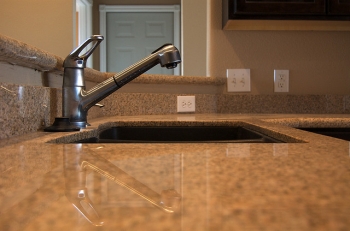Feature and Function in Kitchen Design

The sink in any kitchen design is often a crucial part of the overall plan. The tried, tested and extremely useful ‘work triangle’ is, in many kitchens, the basic layout that is chosen. The position of the sink, fridge and cooker all create this triangle and so choosing their positions early in the design process is crucial. Although sinks are used less these days for doing the washing up, they still feature in kitchens for cleaning purposes and for rinsing or washing food during preparation.
A Chore with a View
Underneath the window is often the location chosen for a sink; this is allegedly due to the need for a view while washing up, but it also has a practical aspect in that drainage is easy when the system lies against an external wall. However, the kitchen sink/window relation is not always necessary or convenient. Forget about the window initially and think about the best place for the sink in order to maximise space and functionality; if it’s under the window then all well and good but if it is not then don’t be put off by the raised eyebrows and sharp intake of breath from your builder.
Practical Choices
Sinks come in all sorts of material these days; ceramic has seen growth in popularity, while composite stone and synthetic materials are also increasingly popular. Stainless steel sinks can be a good choice in any theme of décor. They’re functional, hygienic and low maintenance, which is probably the reason for their enduring popularity. They’re also an affordable option and can come with pre-fitted kitchen mixer taps and include a draining board.
Standing out or Blending in
There are two main ways to install a sink in a kitchen to ensure that it is functional and aesthetically pleasing. The two preferred methods are under-mounted or inset; both are excellent in their own way and the choice is mainly related to your personal style and the overall design. Under-mounted is where the sink is placed on top of the work-surface and a mixer tap can then be located at the side or behind; this method is suitable for most surfaces and eliminates the cost of cutting out an inset in granite or stone. The under-mounted method works well with shallow ceramic sinks which look great when sat simply and elegantly on a stone or granite work top. For stainless steel the option can also work, but in both cases you will lose a draining board which may affect your decision. Inset sinks are set into the work-surface and are probably the most common method. Kitchen mixer taps can come as part of a unit or be added according to taste and work with both styles of fitting.
The location of your sink, kitchen mixer taps and other fixtures should be a crucial part of any kitchen design. With a range of materials, positions and settings, the kitchen sink should remain an integral and much used part of your kitchen.
